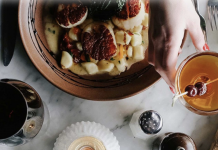
George Dolgikh/Adobe
It seems like often we are enjoying a glass of wine and don’t pay much attention to the food or snacks we may pop into our mouths before and after each sip. Have you had Pinot Grigio with Fritos? What about Cabernet Sauvignon with Doritos? Hey, they both looked good at the time. Or you’re at a party and there is a table full of appetizers, crunchy snacks, cheese and sweets. Oh—there’s Judie’s bean dip; gotta have a bit of that. A slice of Swiss cheese…and wait, Lorrie’s artichoke dip. Brownie bites! All with the same glass of wine. Realistically you are not going to pour five glasses of wine for yourself or dump out and replace the type of wine with each bite. But you may have noticed that slice of cheese made a much better union with the wine than the brownie.
Wine and cheese bring out the best in each other. The protein in cheese softens the tannins in wine, and the right combination can result in a harmonious medley of delicious flavors. It’s similar to the way milk and cookies make a great match while cookies and grapefruit juice, for example, could leave you with a bad taste in your mouth.
Cheese to Please
When you are selecting wine and cheese, strive to have flavors either contrast or complement: Contrast strong blue cheese with sweet port, for example or complement creamy, buttery Chardonnay with creamy, rich Brie. It’s fun to discover your own pairings, but some natural combinations make reliable palate pleasers. There are so many variations, but in general there are certain categories that work better together than others:
• Hard, mild cheeses pair well with most white wines and light reds. (Cheddar cheese with Pinot Gris, Sauvignon Blanc or Beaujolais)
• Hard, mature-flavored cheeses pair nicely with fuller white wines and light reds. (Aged Gouda, Parmigiano-Reggiano or sharp cheddar with Gewürztraminer, Viognier, Beaujolais or a young Zinfandel)
• Soft, mild cheese makes an appealing partner with full whites, light and medium reds, or fortified wine. (Brie or Camembert with Chardonnay, Cabernet Sauvignon, Beaujolais or Pinot Noir)
• Blue cheeses pair well with sweet white wines, full-bodied reds and fortified wine. (Stilton, Gorgonzola or Roquefort with Sauternes, Riesling, Châteauneuf-du-Pape or Cabernet Sauvignon)
• Goat cheese pairs well with fuller whites, medium reds, sparkling wine and fortified wine. (Chèvre with white Burgundy or Spumante)
Pairing Sources
If you are attending the Minnesota Monthly Food and Wine Experience (March 4 and 5 at Target Field) that is a great time to sample an array of cheeses—already cut up in handy bites and there is a wide range of wine being poured for sampling. Check out how a fresh cheese curd may complement that white wine you just tried or a bit of blue cheese marries well with that Cabernet. Or discover some pairings you never thought you would like.
There is also a fun interactive “matchmaker” on the Wisconsin Milk Marketing Board’s website under “Pairing and Sharing” called Cheese Cupid, where you can select a type of wine or cheese and pull up suggested pairings for tasty “soul mates.” There are also suggestions for beer and other spirits that pair well with the selected cheese. Of course, there are many matches to choose from and you may want to play the field—but you might find one you would like to settle down with.
Plan a Party
Hosting a wine and cheese party is a fun way to enjoy your favorite pairings as well as to sample new combinations. It’s also a fast and festive way to bring people together without elaborate preparation.
In general, plan on four ounces of cheese, three ounces of crackers or crusty bread, and half a bottle of wine per person. Olives, nuts and fruit are good choices for additional tasty tidbits.
You can ask guests to bring a bottle of wine and their favorite cheese partner—but coordinate the efforts in order to avoid ending up with multiple combinations of the same wines and cheeses. Try theme pairings: Have each guest bring a wine from a particular European country with a cheese from that same country, or a domestic wine with a domestic cheese.
Provide each guest with two wine glasses—one for reds and one for whites. Wine glass charms are always a fun way to help guests keep track of their glasses. Serve cheese at room temperature in order to bring out its full flavor, keeping in mind that hard cheese takes longer to warm to room temperature than soft after it’s removed from the refrigerator. If you have time, it’s fun to label cheese with markers to identify each variety. Place each bottle of wine next to its best cheese pairing, but explore different combinations. Your experiments may confirm why other pairings are recommended—or you may discover a new combination. (There are many beer and cheese pairings that work well together too.) The most important thing is to relax and have fun and enjoy the harmony of flavors.







